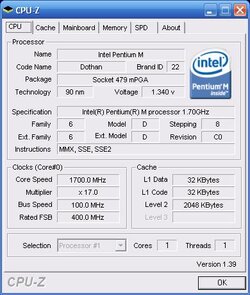One more question, how much variation should be in the clock after the overclock? My cpu fluctuates from quite a bit, heres a log of .1 second intervals,
19:04:47, 1731.63 MHz, (-0.0%)
19:04:47, 1806.62 MHz, (0.0%)
19:04:47, 1949.77 MHz, (100.0%)
19:04:47, 1850.38 MHz, (0.0%)
19:04:47, 1762.16 MHz, (0.0%)
19:04:47, 2014.61 MHz, (-0.0%)
19:04:47, 1764.74 MHz, (0.0%)
19:04:47, 2097.92 MHz, (0.0%)
19:04:47, 1791.40 MHz, (100.0%)
19:04:47, 1808.98 MHz, (0.0%)
19:04:47, 2044.83 MHz, (-0.0%)
19:04:47, 1819.80 MHz, (-0.0%)
Is this normal, since i havent checked before the pin mod?
19:04:47, 1731.63 MHz, (-0.0%)
19:04:47, 1806.62 MHz, (0.0%)
19:04:47, 1949.77 MHz, (100.0%)
19:04:47, 1850.38 MHz, (0.0%)
19:04:47, 1762.16 MHz, (0.0%)
19:04:47, 2014.61 MHz, (-0.0%)
19:04:47, 1764.74 MHz, (0.0%)
19:04:47, 2097.92 MHz, (0.0%)
19:04:47, 1791.40 MHz, (100.0%)
19:04:47, 1808.98 MHz, (0.0%)
19:04:47, 2044.83 MHz, (-0.0%)
19:04:47, 1819.80 MHz, (-0.0%)
Is this normal, since i havent checked before the pin mod?
 ) I'm going to give the mod another try. To be honest with you, I think I remember tightening the ZIF socket
) I'm going to give the mod another try. To be honest with you, I think I remember tightening the ZIF socket 